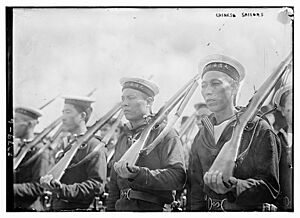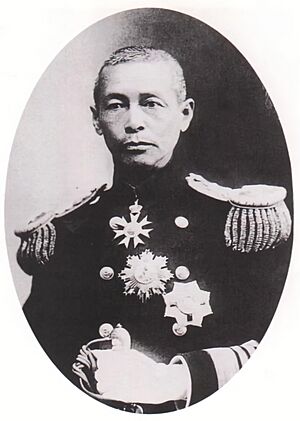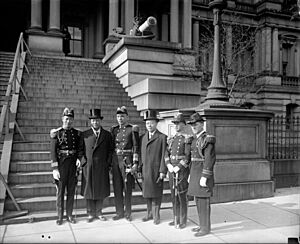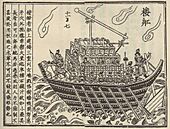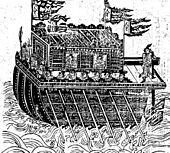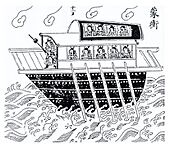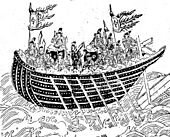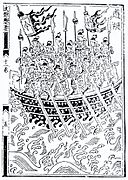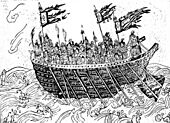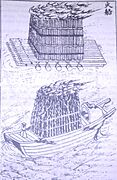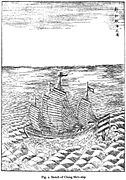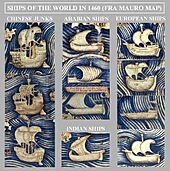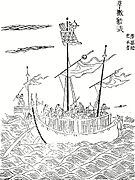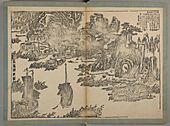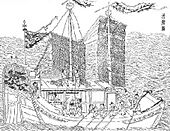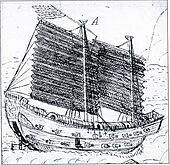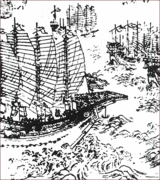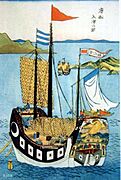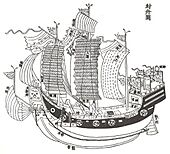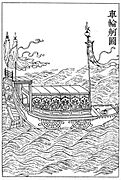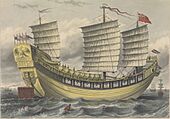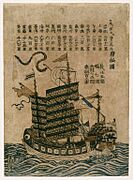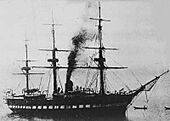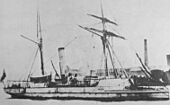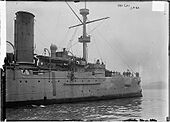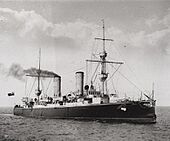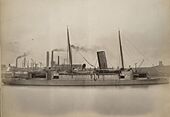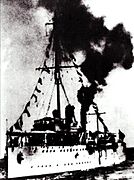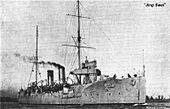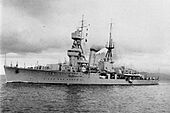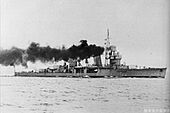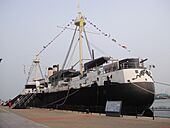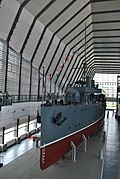Naval history of China facts for kids
The naval history of China goes back thousands of years! Records show that the Chinese navy and its different types of ships were used in wars even during the late Spring and Autumn period. Between 1400 and 1433, the Ming dynasty in China was a top sea power worldwide. Chinese shipbuilders created huge ocean-going ships called junks, and the Chinese emperor sent out seven big sea trips. Today, both the People's Republic of China and the Republic of China have their own navies. These are the People's Liberation Army Navy and the Republic of China Navy.
Contents
Early Ships and Sea Adventures

The Han dynasty created China's first official navy, called the Tower Ship Navy. Even though big sea battles happened before the 12th century, like the Battle of Chibi in 208 AD, China got a permanent navy later. The Song dynasty (960–1279) set up this standing navy in 1132.
At its strongest, by the late 12th century, this navy had 20 squadrons with about 52,000 marines. Their main base was near modern Shanghai. The Southern Song dynasty needed this navy to protect against the Jin dynasty from the north. It also helped guard merchant ships traveling to the Indian Ocean and beyond for trade.
However, for a long time, China's main enemies were land-based groups like the Mongols. So, the navy was seen as less important than the army. By the 15th and 16th centuries, China's canals and economy grew strong internally. This made the big ocean fleet seem less needed. Later, leaders who preferred focusing on China's inner affairs reduced the navy.
After the First and Second Opium Wars, which were tough for China, the government started to care more about its navy.

When the British Royal Navy met the Chinese navy during the First Opium War, they saw paddle-wheel boats. The British thought these were copies of Western designs. But the Chinese had actually developed paddle-wheel boats on their own much earlier, in the 5th–6th centuries!
Chinese ships in the Middle Ages had many smart ideas that Western and Islamic countries didn't use until much later. For example, Chinese ship hulls were divided into watertight sections. If one part of the hull broke, only that section would fill with water, not the whole ship. This meant the ship might not sink! A writer named Zhu Yu described this in his book Pingzhou Table Talks in 1119 AD.
Other improvements included:
- Stronger ships with crossbeams bracing their ribs.
- Rudders that could be moved up or down, allowing ships to sail in different water depths.
- Anchors with teeth all around, making them more reliable.
- Junks had sails that could be raised or lowered easily from the deck, like window blinds. This made it simple to turn or change speed without climbing ropes.
A very important sea battle was the Battle of Lake Poyang in 1363 AD. This battle helped Zhu Yuanzhang win the Red Turban Rebellion and start the Ming dynasty.
After the amazing sea trips led by Admiral Zheng He under the Yongle Emperor, China's leaders changed their minds about growing the navy. They either limited it or didn't pay much attention to it.
Even with less focus, the Chinese treasure fleet was still powerful. It could control other Asian navies. This allowed the Ming dynasty to send governors to places like Luzon and Palembang. They could even choose who ruled in Sri Lanka and the Bataks.
However, the Chinese fleet became much smaller. Its main job changed from exploring and collecting tribute to mostly policing routes like the Grand Canal. Giant ships like those in Zheng He's "treasure fleet" were stopped. These ships were many times bigger than the largest European ships of that time! The junk became the main Chinese ship until China started building modern navies much later.
In 1521, Ming naval junks beat a Portuguese caravel fleet at the Battle of Tunmen. Then, in 1522, they won another battle against the Portuguese at Battle of Xicaowan. In 1633, the Ming navy defeated a combined Dutch and Chinese pirate fleet at the Battle of Liaoluo Bay. Many books about naval warfare were written during the Ming period, like the Wubei Zhi. Also, shipwrecks found in the South China Sea show Chinese trade and war ships from around 1377 and 1645.
The "sea ban" policy in the early Qing dynasty meant that naval power didn't grow. River and coastal defense was handled by the Green Standard Army.
In 1661, a naval unit was created in Jilin to defend against Russian attacks. More naval units were added to different Banner groups, forming the "Eight Banners Navy." In 1677, the Qing court rebuilt the Fujian Fleet to fight the Kingdom of Tungning (Ming loyalists) based in Taiwan. The Qing won the Battle of Penghu in 1683, and Tungning surrendered. The Second Opium War showed that China's old-style fleet was no match for modern European navies. About 300 Chinese junks, even with British-made guns, did almost no damage to 56 British and French ironclads.
In the 1860s, there was an attempt to build a modern navy with British-built ships. This "Vampire Fleet" was meant to fight rebels. But it was scrapped because of disagreements about who the British commander should report to.
The Imperial Chinese Navy had four main fleets:
- Beiyang Fleet - The North Sea Fleet, based near Weihaiwei.
- Nanyang Fleet - The South Sea Fleet, based near Shanghai.
- Guangdong Fleet - Based near Canton (now Guangzhou).
- Fujian Fleet - Based near Fuzhou, started in 1678.
In 1865, the Jiangnan Shipyard was built, which was important for building ships.
In 1874, Japan attacked Taiwan, showing how weak China was at sea. A plan was made to create three modern coastal fleets. The Beiyang Fleet, protecting the area closest to the capital Beijing, was given top priority.
China ordered warships from Britain and Germany in the late 1870s. Naval bases were built at Port Arthur and Weihaiwei. The first British ships arrived in 1881, and the Beiyang Fleet officially started in 1888. Many Chinese military families sent their children to study in the United States to help modernize the navy. However, they couldn't join military academies like West Point.
By 1894, the Beiyang Fleet was supposedly the strongest navy in Asia. But it was mostly destroyed during the First Sino-Japanese War after the Battle of the Yalu River. This defeat allowed the Japanese army to invade China. Even though the modern battleships Zhenyuan and Dingyuan were very strong, they couldn't sink any Japanese ships. All eight Chinese cruisers were lost. This battle showed that China's efforts to modernize were not as successful as Japan's.
The Nanyang Fleet was created in 1875. It grew with mostly Chinese-built warships and a few from Britain and Germany. It fought in the Sino-French War but didn't do well. This loss helped the French take control of Southeast Asia. It also encouraged the British to take over Burma.
The Fujian and Guangdong fleets joined the Imperial navy after 1875. The Fujian Fleet was almost destroyed during the Sino-French War. By 1891, it was barely able to function due to money problems. Much of the navy's money was reportedly used by the Empress Dowager Cixi to fix up her Summer Palace and build a Marble Boat. The Guangdong Fleet was started in the late 1860s. In 1909, ships from this fleet sailed around the South China Sea to show China's control.
After the First Sino-Japanese War, Zhang Zhidong created a river-based fleet in Hubei.
In 1909, the remaining parts of the Beiyang, Nanyang, Guangdong, Fujian, and Hubei fleets were combined. They were reorganized into the Sea Fleet and the River Fleet.
In 1911, Sa Zhenbing became the Minister of Navy for the Great Qing.
One new ship, the cruiser Hai Chi, made history in 1911. It was the first Chinese ship to visit American waters, stopping in New York City.
The Republic of China Navy (ROCN) is the navy of the Republic of China. It was formed after the 1911 Revolution overthrew the Qing dynasty. Liu Guanxiong, a former Qing admiral, became its first Minister of Navy. During the Warlord Era (1920s-1930s), the ROCN stayed loyal to the Kuomintang government. During World War II, the ROCN mostly fought on rivers. It was not strong enough to fight the Imperial Japanese Navy on the ocean. Today, the ROCN protects the island of Taiwan.
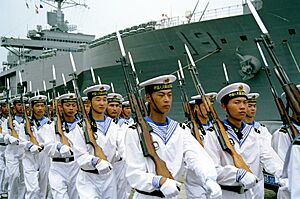
The People's Liberation Army Navy (PLAN) was created in 1950 for the People's Republic of China. It started from naval units that fought in the Chinese Civil War. At first, the PLAN focused on defending China's coast. It protected against raids from Taiwan. It also played a role in the First and Second Taiwan Strait Crises.
In the 1950s and early 1960s, the Soviet Union helped the PLAN. They provided advice, equipment, and technology. This help stopped after the Sino-Soviet split. Until the late 1980s, the PLAN was mainly a river and coastal force. But in the 1990s, after the Soviet Union broke up, China's military leaders could focus less on land borders. They started to look more towards the seas. This led to the PLAN becoming a green-water navy by 2009. Before the 1990s, the PLAN was usually less important than the army.
In 2020, the PLAN became the largest navy in the world by number of ships. However, the U.S. Navy still had more advanced technology. This growth happened as tensions between China and the United States increased. China also became more involved in territorial disputes in the South China Sea.
Early Writings on Sea Battles
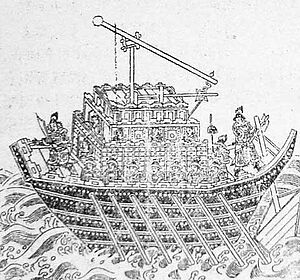
One of the oldest Chinese books about naval matters is the Yuejueshu (Lost Records of the State of Yue) from 52 AD. It was written by the Han dynasty scholar Yuan Kang. Parts of this book were later put into other important collections.
Yuan Kang's book listed different types of war boats. One type was used for ramming, like the ships of ancient Phoenicia. These ship types included:
- The great wing (da yi)
- The little wing (xiao yi)
- The stomach striker (tu wei)
- The castle ship (lou chuan)
- The bridge ship (qiao chuan)
These were described in a conversation between King Helü of Wu and Wu Zixu. Wu Zixu said that naval forces should use land army tactics. He compared great wing ships to heavy chariots and castle ships to mobile assault towers.
Chinese people also used a large iron hook on a pole to stop enemy ships. This was described in the Mozi book from the 4th century BC. This hook-and-pole method was a key reason why the Yue navy lost to the Chu navy.
The Book of Later Han tells about a rebellion in 33 AD. A rebel leader sent a large naval force down the Yangtze River. He built a long floating bridge across the river with forts to protect it. The Han commander, Cen Peng, couldn't break through at first. Then, he used a fleet of thousands of ships, including castle ships and ramming vessels. He defeated the rebellion.

The 'castle ship' design continued to be used after the Han period. When fighting the navy of the Chen dynasty on the Yangtze River, Emperor Wen of Sui used a huge navy. His largest ships had five decks and could hold 800 people. Each ship had six 50-foot-long poles to swing and damage enemy ships.
Ships of the Tang Dynasty
During the Chinese Tang dynasty (618–907 AD), there were important naval battles. One was the Tang-Silla victory over Korean and Japanese forces in the Battle of Baekgang in 663. Tang dynasty writings about naval warfare and ship design became more detailed. In his book Taipai Yinjing (759 AD), Li Quan described several types of naval ships. Later, in 784 AD, the Tang Prince Li Gao invented paddle-wheel ships. These paddle-wheel ships, along with gunpowder bombs, were a big reason for the Song dynasty's victory in the Battle of Caishi in 1161 AD.
Covered Swoopers
Covered swoopers (Meng chong, 蒙衝) were ships with armored roofs made of rhinoceros hide. They had openings on the sides for oars and holes for crossbows and spears. Enemy groups couldn't get on these ships, and arrows or stones couldn't hurt them. These ships were not for regular fighting. They were used for fast, surprise attacks because they were quick and easy to move.
Combat Junks
Combat junks (Zhan xian) had strong walls above the ship's sides, with oar-ports below. They also had a deckhouse with more walls, doubling the fighting space. These ships had no roof. They flew many flags and used gongs and drums. These were the true fighting ships.
Flying Barques
Flying barques (Zou ge) were another type of fighting ship. They had two rows of walls on the deck. They carried more sailors and fewer soldiers, but the soldiers were the best and bravest. These ships moved very fast, like they were flying. They could attack enemies by surprise and were great for urgent missions.
Patrol Boats
Patrol boats (Yu ting) were small ships used to gather information. They didn't have walls above the hull. They had rowlocks every four feet on both sides. These boats were very fast, whether going forward, stopping, or turning. But they were only for reconnaissance (scouting), not for fighting.
Sea Hawks
Sea hawks (Hai hu) had low fronts and high backs, shaped like a hu bird floating on water. Below the deck, on both sides, they had 'floating-boards' that looked like the bird's wings. These helped the ships stay steady even in strong winds and waves. Raw ox-hides covered the upper parts of the ship for protection, like a city wall. They had flags, gongs, and drums, just like the fighting ships.
Ships from the Wujing Zongyao
-
A "tower" ship with a traction-trebuchet on its top deck, from the Wujing Zongyao
-
A "combat" ship from the Wujing Zongyao
-
A "covered assault" ship from the Wujing Zongyao
-
A "flying" barque from the Wujing Zongyao
-
A "patrol" boat from the Wujing Zongyao
-
A "sea hawk" ship from the Wujing Zongyao
-
Chinese fire ships from the Wujing Zongyao
Ancient China (Spring and Autumn, Warring States, Qin, Han)
- Spring and Autumn period: Wars between the states of Wu and Qi.
- Warring States: Wars between Yue and Chu.
- Qin dynasty:
- Han dynasty:
- 111 BCE: Explorers from Emperor Wu of Han traveled through Southeast Asia and India. They aimed to connect with Central Asian states, creating the "Silk Road of the Sea."
- Rebellion of Gongsun Shu
- Battle of Chibi (also known as Battle of Red Cliffs) - A very famous large-scale naval battle.
Three Kingdoms to Song Dynasty
- Three Kingdoms:
- Battle of Dongkou
- Battle of Jiangling (223)
- Sui dynasty:
- Goguryeo-Sui Wars
- Tang dynasty:
- Battle of Baekgang - A victory for Tang and Silla forces.
- Song dynasty:
- Battle of Caishi
- Battle of Tangdao
- Battle of Xiangyang
- Battle of Yamen
Yuan and Ming Dynasties
- Yuan dynasty:
- Third Battle of Bạch Đằng
- First Battle of Hakata Bay
- Java Expedition
- Ming dynasty:
- Battle of Lake Poyang - A huge battle that helped establish the Ming dynasty.
- Ming treasure voyages led by Admiral Zheng He.
- Wokou - Pirates who raided the coast.
- Imjin War - A war involving Korea, China, and Japan.
- Battle of Liaoluo Bay
Qing Dynasty to Modern Day
- Qing dynasty:
- The Qing dynasty had 7 fleets across 4 sea zones for defense.
- The modern Imperial Chinese Navy was created in 1875.
- First and Second Opium Wars - Showed the weakness of China's old navy.
- First Sino-Japanese War - A major defeat for the Imperial Chinese Navy.
- Republic of China:
- Republic of China Navy
- Second Sino-Japanese War
- First Taiwan Strait Crisis
- People's Republic of China:
- People's Liberation Army Navy
- Battle of the Paracel Islands
- Spratly Island Skirmish (1988)
-
Ships from around the world as shown on the Fra Mauro map from 1460.
See also
- Military history of China before 1912
- History of canals in China
- Chinese exploration
- Imperial Chinese Navy


